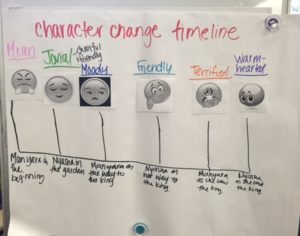One of the biggest challenges teachers face today is designing instruction that allows English Language Learners to access both language and content in powerful ways. Much has been written and resources abound, but the complex task of planning and executing engaging, differentiated lessons that stick is just not that simple.
This year I’ve been a part of a collaborative team on a campus with a sizable number of ELLs; many of whom are newcomers. Designing lessons for students learning English is tricky enough, but finding ways to deliver instruction and assess for kids that are new to the U.S. is even more daunting.
I have learned volumes this year planning regularly with this collaborative team that includes two teachers, the campus instructional specialist and our district ESL/bilingual facilitator.
When we meet, we start by planning instruction based on the state standards and our district curriculum lesson guide. Once we’ve planned the content of the week’s instruction, we turn to designing the formative assessments and then specific ways to differentiate for the ELL students in the class.
What we’ve discovered, by the way, is that the differentiated instruction we design for ELL students has worked well in meeting instructional needs of the students with disabilities who are present in the classroom during a portion of the language arts block.
We’ve come upon a few simple, yet profound beliefs that guide our instructional planning. You won’t be surprised to find that these ideas are firmly rooted in research.
Instruction must be explicit, task-specific, and easily grasped.
Content specific instruction must be clearly understood and easily transferable, i.e., comprehensible input. The mini-lesson must be designed with rich visuals, simple yet content-specific language, and adequate time to process.
Recently the teachers that are a part of our team were to model how readers pay attention to how characters change over time when reading fiction. We spent time collaboratively planning a mini-lesson that would be clear to the newcomers in these classrooms. Our inspiration was a lesson we found in The Reading Strategies Book by Jennifer Serravallo. We took her anchor chart and changed it a bit to meet the specific needs of our newcomers.
Anchor charts are a must for all readers, but particularly important for ELL newcomers.
The teachers chose to start the lesson by reading a short, powerful text with noticeable changes in the characters. To model for students, a timeline was drawn and emojis were used to show how the main character’s feelings had changed over the course of the story.
A word-bank of emotion words along with matching emoticons was prominently displayed in the meeting area during the mini-lesson.
Practice with language and content must be varied and plentiful.
Opportunities to practice proficient reader skills and articulate content vocabulary both with assistance and independently must be built into the instruction.
Our team collaboration includes time to specifically plan how/when ELL students will turn and talk with other students during the mini-lesson, creative ways for them to be included in group work and thoughtful, content-specific, differentiated formative assessments.
We spend time discussing what we believe the newcomer students need to be able to articulate (either verbal or written, sometimes this includes a simple sketch) in order to cement the learning for them.
The differentiated task we planned for the ELL students was to create a timeline with emojis and include emotion words. A native speaker was partnered with each newcomer and the emotion words were read aloud as the ELL students wrote the words in the appropriate place on the timeline.
The newcomer students were allowed to listen in to native English speakers while they created their character emotion timelines with sketches of the real character and specific text evidence cited on the timeline. The ELL newcomer students were able to be a part of the rich, content-based conversation in each cooperative learning group and still show their thinking in a differentiated format.
Output that is aligned to content standards
This, I think is the most difficult part of planning and practice for the classroom teacher. Most teachers understand and work hard to make content knowledge comprehensible for their ELL students, but I believe we often fall short of finding ways to allow our newcomers to show us what they know.
One of the most important conversation we have each time our team meets is focused on this one question, “How will we know when students have learned the content?”
The formative assessments planned to give the teacher knowledge of how native English speaking students are learning is important, but taking extra time to plan aligned assessments for newcomer ELLs is crucial.
The photo in the section above (the differentiated timeline) is a powerful example of the work the newcomer student produced as a result of their own learning. That student sample also acts as an aligned assessment that gives the teacher clear evidence of student learning.
Too often we give simple, even menial assignments in class to our newcomer ELLs that are clearly language learning activities, versus content specific tasks. The language acquistion work is more appropriately assigned by the ELL teacher during pull out time for our newcomers. The learning in class should be closely aligned to the content which is specifically matched to the standard.
It’s tricky, but it’s doable.
One of the teachers on our planning team recently designed an assessment for a lesson on main idea/details for her newcomer student. A partner read a short passage as the ELL student was to sketch what the passage was mostly about. When the teacher came around to check in, she asked the student to talk about details from the passage (which the student was able to do). As a part of the assessment, the teacher also asked the student to paraphrase (academic vocabulary for this particular lesson) the text.
The student was able to perform that task using uncomplicated words and phrases as they pointed back to the sketches they’d made. The teacher had a simple handwritten checklist at the top of the page that she had added to the sketch pages before the student began the task. It was clear to the student beforehand how they were to “show what they know” and the teacher had a simple way of assessing student learning.
This powerful process of collaborative planning with a commitment to research based practices for ELLs has served our team well this year as we’ve designed instruction for these 3rd grade newcomer students. It is inspiring to see the work that the teachers and these ELLs have engaged in this year. I have learned much and I am incredibly optimistic about the progress our newcomer ELLs will undoubtedly make during this school year.
What do you do to support ELL newcomers that you can share with us? How do you collaborate so the task of planning for differentiation is manageable?













Oh so proud of this work!